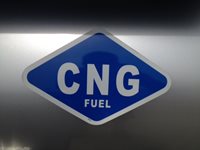Most of my friends that drive and read this will start out with the mindset that natural gas would never work for them! Of course, part of this comes from the fear of the unknown, which we know is NEVER a problem amongst truck drivers (cue the sarcastic undertones)! My typical reply to those with this response is, “I guess it WOULDN’T work for you then!” This usually tends to raise an eyebrow, as they think my task is to try and sell them on converting to CNG. Lets start off by saying that I by no means think it is for everyone out there. If you do not have the vision and foresight to consider the savings over the long run, then you might be better off not diving into the realm of CNG thinking. If you ARE willing to work around some of the downsides though and analyze the numbers of this technology in your own specific application, I believe it can prove to be a money saving option for most involved in local, regional, or predictable route-type scenarios. Proof of the growing trend of fleets adding natural gas vehicles (NGV’s) can be found in various trucking industry forms of media, such as the one I just read from NGVAmerica in the Fleets and Fuels Newsletter (http://www.fleetsandfuels.com/fuels/cng/2014/08/ngvs-20-growth-isnt-crawling/)
In this article they were proud to announce an annual growth rate of 20% for natural gas vehicles. A 20% growth rate for anything is remarkable in my book, especially since there are a lot of current plans in the works to grow it even more. This led me to start looking around even harder to spot the true sign of growth, which to me is checking the roadways I travel and looking for that familiar little blue sticker that indicates that a vehicle runs on natural gas. To my surprise, I found it easier than I thought to locate a great amount of these vehicles on the road. The vast diversity amongst vehicle types is what really caught me off guard and opened my eyes to the fact that natural gas is here to stay as a leading contender amongst clean alternative fuel options. While looking for different natural gas options I saw passenger vehicles, taxicabs, municipal buses, county and city pickup trucks, passenger and equipment vans, as well as commercial trucks. Breaking it down even further amongst the commercial truck side of things, I was able to count trucks involved in many different applications including refuse hauling, port drayage, grocery delivery, bakery delivery, package delivery, and of course my own truck that involved in rail intermodal.

Diversity alone does not drive an industry, but it definitely can’t hurt when you have such a wide array of uses for a single fuel source. Since the introduction of the Cummins Westport ISX12 G 11.9-liter engine, the commercial applications have opened up even more. This combined with the exploding infrastructure of fueling stations can, in my opinion, are a couple of reasons that NGV’s are being added to major fleets nationwide. The fuel is there, the savings are there, the technology is there, and it is up to those willing to pioneer new territory to lead the way in proving that natural gas can continue to rise to the top of the alternative fuel market in the United States.